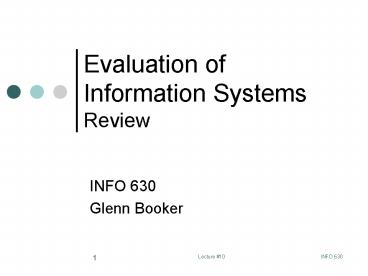Evaluation of Information Systems Review - PowerPoint PPT Presentation
1 / 22
Title:
Evaluation of Information Systems Review
Description:
GQ(I)M. We used the goal, question, indicator, and measure methodology to: Help understand why we are collecting the measures, Define exactly what they mean, ... – PowerPoint PPT presentation
Number of Views:66
Avg rating:3.0/5.0
Title: Evaluation of Information Systems Review
1
Evaluation of Information SystemsReview
- INFO 630
- Glenn Booker
2
Measurement Overview
- We have studied the kinds of measurement methods
and characteristics needed for software
development and maintenance - Weve used SPSS to do the icky math parts for
us, and emphasized understanding what kinds of
techniques are used, and how to interpret their
results
3
Life Cycle Model
- Most of our concepts are based on some variation
of the key software development activities - Requirements analysis
- High and low level design
- Coding or implementation
- Various levels of testing
4
Motivation
- Measurement is critical from a project management
perspective, to give us an objective basis for
making decisions and answering questions - It also helps fulfill objectives of various
quality and process models (CMMI, ISO 9000, etc.)
5
Foundation
- We defined measurements for each aspect of a
process - The product we create
- The resources (people) we use to create it
- The processes they follow
- The tools they use
6
Statistical Concepts
- Key statistical concepts used include
- Measurement scales (nominal, etc.)
- Ratio, proportion, fraction, percent, and rate
- Modeling to see if theres a statistically
significant relationship between two measures - And assess R squared and T to help make that
judgement
7
Normal Distribution
- We reviewed the normal distribution
- The 95 rule for deciding how close to the mean
is close enough to be important - Six Sigma
8
Core Measurements
- The most common foundation for measurement is
- Product Size (LOC or function points)
- Effort and cost
- Schedule
- Problems and defects, including the defect
density (defects/KLOC)
9
Development and Defect Models
- We considered development models to relate
various key measures to each other (COCOMO) - And examined defect removal effectiveness
10
Quality Management
- We looked at key aspects of a Quality Management
System and key development and maintenance
metrics often used - Defect arrival rate
- Fix backlog
- Fix response time
- Etc.
11
Earned Value
- We looked to the earned value method for
comparing the effort, schedule, and work
accomplished during a project - ACWP, BCWP, BCWS, CPI, SPI if you still
remember what they mean, you deserve a cookie! - Cost and schedule variances, schedule slip,
estimate at completion
12
GQ(I)M
- We used the goal, question, indicator, and
measure methodology to - Help understand why we are collecting the
measures, - Define exactly what they mean,
- Where they come from
- How they will be presented (the indicators)
13
Defect Analysis
- Defect analysis looked at
- When a defect was created (injected)
- When a defect was found (detection)
- What caused a defect (type of defect, and/or
orthogonal defect classification) - How a defect was found (triggers)
14
Defect Removal Modeling
- Defect removal modeling defined the defect
removal effectiveness (DRE) for any set of
adjacent life cycle phases - Then the Rayleigh model provided a mathematical
expression to help predict how many more defects
will be found during development
15
Reliability Modeling
- Static reliability models provide a detailed
estimate of defects per module based on size and
complexity metrics - Dynamic reliability models provide a broader
estimate of the defects in the entire project,
such as the Rayleigh model (from the Weibull
model)
16
Reliability Modeling
- Lots of other types of reliability models were
covered briefly - Exponential model for testing
- Time Between Failure Models
- Fault Count Models
- Time Between Failures
17
Customer Satisfaction
- We discussed ways of conducting Customer
Satisfaction Surveys - Statistical sampling methods
- How to calculate simple random sample size
- Analysis of customer satisfaction data
18
Testing Measurements
- We discussed approaches to testing
- Testing measurements beyond just defects found
- Structural and predicate testing
- Integration testing strategies
19
Object Oriented Measures
- We covered six common OO metrics
- Weighted methods per class (WMC)
- Response for a class (RFC)
- Lack of cohesion of methods (LCOM)
- Coupling between objects (CBO)
- Depth of inheritance tree (DIT)
- Number of children (NOC)
20
Complexity Metrics
- We examined internal and external complexity
metrics - Internal size, the Halstead metrics, cyclomatic
complexity, knots - External data structure, fan in, fan out, Henry
and Kafura, Shepperd - And looked at availability metrics
21
Quality Assessment and Audit
- We looked at quality assessments and quality
audits, and their common structure - Preparation phase
- Evaluation phase
- Summarization phase
- And examined the larger view of the Process
Assessment Cycle
22
CMMI Structure
- Finally we reviewed the structure of the CMMI
process model - Staged versus continuous models
- Process Areas and their goals, etc.
- And thats it!

